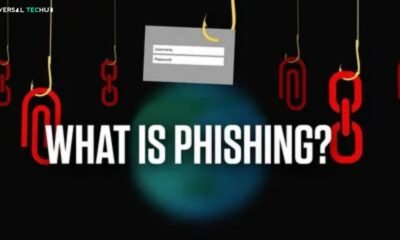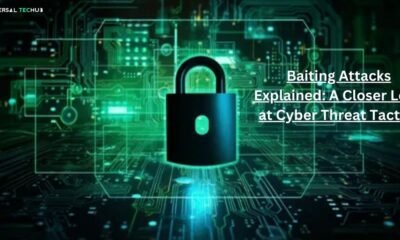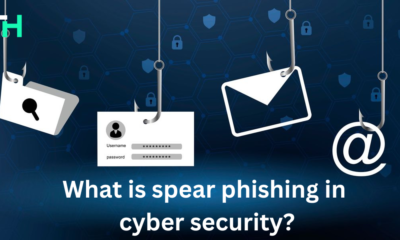Cybersecurity
How does Vishing Work in Cybersecurity?

Vishing attacks follow a structured social engineering process to deceive victims into giving up sensitive information. Below is a step-by-step breakdown of how these attacks operate:
1. Pretexting and Target Research
Cybercriminals gather background information on their target before initiating the attack. This is known as pretexting, where scammers create a believable backstory to gain the victim’s trust.
- Attackers collect personal details from social media, data breaches, or public records.
- They use this information to craft a convincing identity, such as a bank representative, government official, or IT support personnel.
Example: A scammer finds out that a target recently applied for a loan and calls them, pretending to be their bank’s loan officer, requesting verification details.
2. Caller ID Spoofing & Voice Manipulation
To make the scam appear more legitimate, attackers use caller ID spoofing, which disguises their phone number to appear as a trusted organization.
- Scammers may alter their phone number to resemble a bank, hospital, or police station.
- With advancements in AI, attackers can deepfake voices to impersonate real people, such as CEOs or company executives.
Example: A fraudster calls a company’s HR department using AI-generated voice cloning of the CEO, instructing them to transfer funds to a specific account.
3. Psychological Manipulation & Social Engineering
Attackers exploit human emotions such as fear, urgency, trust, and greed to manipulate victims into taking immediate action.
Common vishing tactics include:
✔ Urgency & Threats – “Your bank account has been compromised! Act now, or your funds will be frozen!”
✔ Authority & Trust – “I’m calling from the IRS. You have unpaid taxes, and legal action will be taken against you unless you pay immediately.”
✔ Financial Reward Scams – “You’ve won a lottery! We need your banking details to process your payment.”
Example: A scammer pretends to be an IT support technician, claiming there’s an issue with the victim’s computer. They instruct the victim to install a remote access tool, allowing the attacker to steal data.
4. Extraction of Sensitive Information
Once the victim is convinced, the scammer coaxes them into providing confidential details such as:
- Bank account numbers & card details
- Usernames, passwords, and OTPs (One-Time Passwords)
- Social Security Numbers (SSNs) and personal identification details
- Company login credentials
The extracted data is then used for identity theft, financial fraud, or further cyberattacks.
5. Exploitation and Fraud
After obtaining sensitive information, attackers quickly use it before the victim realizes the fraud:
- Draining bank accounts or making unauthorized transactions
- Using stolen credentials for further hacking attempts
- Selling the data on the dark web
- Launching business email compromise (BEC) attacks or ransomware campaigns
Real-World Examples of Vishing Attacks
1. The Citibank Vishing Scam
In 2020, hackers posed as Citibank employees and called customers, claiming fraudulent activity on their accounts. Victims were asked to verify their identity by providing login credentials and OTPs. The scammers then gained access to bank accounts and stole funds.
2. The Tech Support Scam
A common vishing scheme involves attackers pretending to be from Microsoft or Apple tech support, warning victims of a virus on their computer. They instruct the victim to install remote-access software, which gives hackers complete control over the device.
3. AI-Driven CEO Fraud
In 2019, cybercriminals used AI-generated deepfake voice technology to impersonate the CEO of a UK-based energy company. The attacker convinced an employee to transfer $243,000 to a fraudulent account.
AI-Driven Vishing: A New Cybersecurity Threat
Advancements in AI and deepfake voice technology have made vishing attacks more convincing and dangerous. Cybercriminals can:
🔹 Clone voices of CEOs, managers, or celebrities to manipulate employees or customers.
🔹 Use AI-powered chatbots to conduct large-scale vishing campaigns.
🔹 Automate phishing calls using text-to-speech AI models.
Example: In 2023, fraudsters used AI voice cloning to mimic a CEO’s voice, tricking a finance employee into transferring millions of dollars to an offshore account.
How to Protect Yourself from Vishing Attacks
1. Verify the Caller’s Identity
✔ Always hang up and call back using an official phone number.
✔ Cross-check the caller’s credentials with the official website.
2. Never Share Sensitive Information
✔ Banks and government agencies never ask for passwords, PINs, or OTPs over the phone.
✔ Avoid sharing financial details unless you are 100% sure of the caller’s legitimacy.
3. Use Call Blocking and Authentication Tools
✔ Enable call-blocking apps to detect and block scam calls.
✔ Implement multi-factor authentication (MFA) for extra security.
4. Be Aware of Psychological Manipulation
✔ Scammers create urgency and panic to pressure victims.
✔ Always stay calm and analyze the situation logically.
5. Educate Employees and Family Members
✔ Organizations should conduct security awareness training to recognize vishing scams.
✔ Teach family members, especially elderly individuals, about common vishing tactics.
Conclusion
Vishing is a growing cybersecurity threat that uses voice-based deception to manipulate victims into revealing sensitive information. With the rise of AI-powered voice phishing, businesses and individuals must stay vigilant against fraudulent calls.
By verifying caller identities, never sharing sensitive data, and using cybersecurity tools, you can protect yourself from falling victim to vishing scams.
Would you like me to add a table of real-world vishing scams or infographic suggestions? 🚀
Read More
Vishing Definition in Cybersecurity
What does Vishing stand for?
Google Voice Verification Code Scam what to do
-

 Phishing attack8 months ago
Phishing attack8 months agoWhat is Spear Phishing and How You Can Identify This Scam?
-

 Social engineering attack10 months ago
Social engineering attack10 months agoBaiting Attacks Explained: A Closer Look at Cyber Threat Tactics
-

 Social engineering attack8 months ago
Social engineering attack8 months agoWhat are Social Engineering Attacks – A Complete Guide to Cyberattacks Prevention
-

 Social engineering attack9 months ago
Social engineering attack9 months agoSpear Phishing Attack: A Targeted Cyber Threat
-

 Social engineering attack10 months ago
Social engineering attack10 months agoWhat is spear phishing attack? A detailed guide
-

 Phishing attack4 months ago
Phishing attack4 months agoWhy is Phishing Still a Major Cyber Threat? Everything You Need to Know
-

 Social engineering attack10 months ago
Social engineering attack10 months agoWhat is spear phishing in cyber security?
-

 Phishing attack8 months ago
Phishing attack8 months agoWhat Are Phishing Emails? A guide for you




















